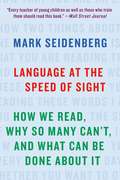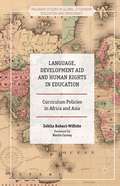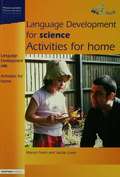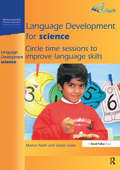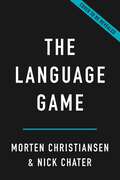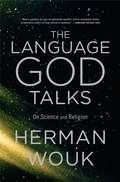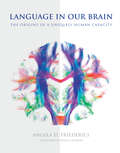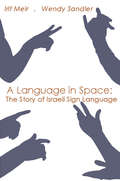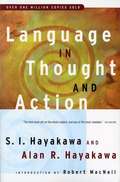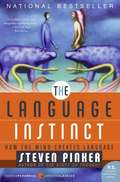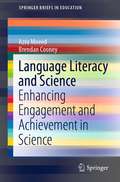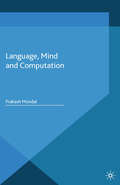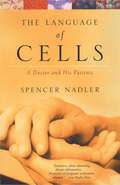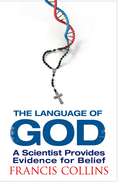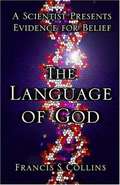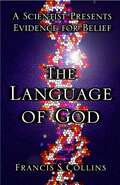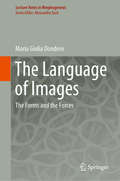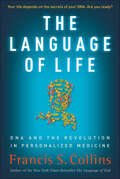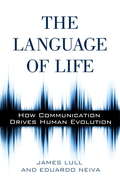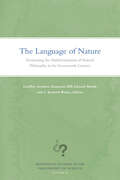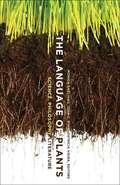- Table View
- List View
Language at the Speed of Sight: How We Read, Why So Many Can't, And What Can Be Done About It
by Mark SeidenbergAccording to a leading cognitive scientist, we've been teaching reading wrong. The latest science reveals how we can do it right. <p><p>In 2011, when an international survey reported that students in Shanghai dramatically outperformed American students in reading, math, and science, President Obama declared it a "Sputnik moment": a wake-up call about the dismal state of American education. Little has changed, however, since then: over half of our children still read at a basic level and few become highly proficient. <p><p> Many American children and adults are not functionally literate, with serious consequences. Poor readers are more likely to drop out of the educational system and as adults are unable to fully participate in the workforce, adequately manage their own health care, or advance their children's education. <p><p>In Language at the Speed of Sight, internationally renowned cognitive scientist Mark Seidenberg reveals the underexplored science of reading, which spans cognitive science, neurobiology, and linguistics. As Seidenberg shows, the disconnect between science and education is a major factor in America's chronic underachievement. <p><p>How we teach reading places many children at risk of failure, discriminates against poorer kids, and discourages even those who could have become more successful readers. Children aren't taught basic print skills because educators cling to the disproved theory that good readers guess the words in texts, a strategy that encourages skimming instead of close reading. <p><p>Interventions for children with reading disabilities are delayed because parents are mistakenly told their kids will catch up if they work harder. Learning to read is more difficult for children who speak a minority dialect in the home, but that is not reflected in classroom practices. By building on science's insights, we can improve how our children read, and take real steps toward solving the inequality that illiteracy breeds. <p><p>Both an expert look at our relationship with the written word and a rousing call to action, Language at the Speed of Sight is essential for parents, educators, policy makers, and all others who want to understand why so many fail to read, and how to change that.
Language, Development Aid and Human Rights in Education: Curriculum Policies In Africa And Asia (Palgrave Studies In Global Citizenship Education And Democracy Ser.)
by Zehlia Babaci-WilhiteThe debate about languages of instruction in Africa and Asia involves an analysis of both the historical thrust of national government and also development aid policies. Using case studies from Tanzania, Nigeria, South Africa, Rwanda, India, Bangladesh and Malaysia, Zehlia Babaci-Wilhite argues that the colonial legacy is perpetuated when global languages are promoted in education. The use of local languages in instruction not only offers an effective means to contextualize the curriculum and improve student comprehension, but also to achieve quality education and rights in education.
Language Development for Science: Activities for Home
by Marion Nash Jackie LoweThese simple play-based activities are ideal for teachers to copy and give out to parents who want to know how to help their child improve his or her science language skills and have fun at the same time. Activities are linked directly to the school-based Language Development Circle Time sessions, but can also be used independently. There is a clear structure and progression of ideas, with supporting black-line drawings to acts as prompts and simple record - keeping system to support home/school communication.
Language Development for Science: Circle Time Sessions to Improve Language Skills
by Marion Nash Jackie LoweThis book is the first of its kind to help practitioners specifically develop children's language skills in Science. The book incudes: guidelines to help teachers set up, run and assess circle-time sessions ideas for promoting children's thinking skills and emotional literacy video CD containing explanation and demonstration of the programme and its implementation, with comments from staff who have used it.
The Language Game: How Improvisation Created Language and Changed the World
by Morten H. Christiansen Nick ChaterForget the language instinct—this is the story of how we make up language as we go Language is perhaps humanity&’s most astonishing capacity—and one that remains poorly understood. In The Language Game, cognitive scientists Morten H. Christiansen and Nick Chater show us where generations of scientists seeking the rules of language got it wrong. Language isn&’t about hardwired grammars but about near-total freedom, something like a game of charades, with the only requirement being a desire to understand and be understood. From this new vantage point, Christiansen and Chater find compelling solutions to major mysteries like the origins of languages and how language learning is possible, and to long-running debates such as whether having two words for &“blue&” changes what we see. In the end, they show that the only real constraint on communication is our imagination.
The Language God Talks: On Science and Religion
by Herman Wouk"More years ago than I care to reckon up, I met Richard Feynman." So begins THE LANGUAGE GOD TALKS, Herman Wouk's gem on navigating the divide between science and religion. In one rich, compact volume, Wouk draws on stories from his life as well as on key events from the 20th century to address the eternal questions of why we are here, what purpose faith serves, and how scientific fact fits into the picture. He relates wonderful conversations he's had with scientists such as Feynman, Murray Gell-Mann, Freeman Dyson, and Steven Weinberg, and brings to life such pivotal moments as the 1969 moon landing and the Challenger disaster. Brilliantly written, THE LANGUAGE GOD TALKS is a scintillating and lively investigation and a worthy addition to the literature.
Language in Our Brain: The Origins of a Uniquely Human Capacity (The\mit Press Ser.)
by Angela D. FriedericiA comprehensive account of the neurobiological basis of language, arguing that species-specific brain differences may be at the root of the human capacity for language.Language makes us human. It is an intrinsic part of us, although we seldom think about it. Language is also an extremely complex entity with subcomponents responsible for its phonological, syntactic, and semantic aspects. In this landmark work, Angela Friederici offers a comprehensive account of these subcomponents and how they are integrated. Tracing the neurobiological basis of language across brain regions in humans and other primate species, she argues that species-specific brain differences may be at the root of the human capacity for language.Friederici shows which brain regions support the different language processes and, more important, how these brain regions are connected structurally and functionally to make language processes that take place in milliseconds possible. She finds that one particular brain structure (a white matter dorsal tract), connecting syntax-relevant brain regions, is present only in the mature human brain and only weakly present in other primate brains. Is this the “missing link” that explains humans' capacity for language?Friederici describes the basic language functions and their brain basis; the language networks connecting different language-related brain regions; the brain basis of language acquisition during early childhood and when learning a second language, proposing a neurocognitive model of the ontogeny of language; and the evolution of language and underlying neural constraints. She finds that it is the information exchange between the relevant brain regions, supported by the white matter tract, that is the crucial factor in both language development and evolution.
A Language in Space: The Story of Israeli Sign Language
by Irit Meir Wendy SandlerThis English version of A Language in Space: The Story of Israeli Sign Language, which received the Bahat Award for most outstanding book for a general audience in its Hebrew edition, is an introduction to sign language using Israeli Sign Language (ISL) as a model. Authors Irit Meir and Wendy Sandler offer a glimpse into a number of fascinatin
Language in Thought and Action
by Alan R. Hayakawa S. I. HayakawaA revised, updated edition of S. I. Hayakawa's classic work on semantics. He discusses the role of language, its many functions, and how language shapes our thinking. Introduction by Robert MacNeil; Index.
The Language Instinct: How the Mind Creates Language
by Steven PinkerIn this classic, the world's expert on language and mind lucidly explains everything you always wanted to know about language: how it works, how children learn it, how it changes, how the brain computes it, and how it evolved. With deft use of examples of humor and wordplay, Steven Pinker weaves our vast knowledge of language into a compelling story: language is a human instinct, wired into our brains by evolution. The Language Instinct received the William James Book Prize from the American Psychological Association and the Public Interest Award from the Linguistics Society of America. This edition includes an update on advances in the science of language since The Language Instinct was first published.
Language Learning and the Brain: Lexical Processing in Second Language Acquisition
by Ulf SchützeEvery person who encounters or learns another language is faced with the challenge of processing many new words in a short period of time. What are the conditions under which a learner can acquire those words successfully and process them to long-term memory? How do language and memory faculties interact? What role do the senses play in this process? Are factors such as age or individual backgrounds of learners to be considered? Taking the reader on a fascinating journey through the brain to demonstrate how language is processed, Ulf Schütze explains the dynamic environment involved in recording and producing words. The book also discusses how to use information technology, such as Apps, to make the learning of words entertaining and efficient. Describes learning words in another language as a dynamic and fluid process. Provides a strong research base in second language acquisition, psycholinguistics, cognitive psychology, and neurophysiology. Outlines practical applications that are helpful for learners, teachers, researchers, and the general public.
Language Literacy and Science: Enhancing Engagement and Achievement in Science (SpringerBriefs in Education)
by Azra Moeed Brendan CooneyThis book presents the findings of two case studies in the 'Making Connections' two-year project funded by the New Zealand Ministry of Education. It shows how science literacy was improved in a state coeducational school with Pacific Island students from diverse linguistic backgrounds. This book details ideas and strategies relevant to schools where English literacy has an impact on the science engagement and achievement of ethnically diverse student populations. It also presents the teaching as inquiry model and its usage by teachers to improve aspects of their teaching strategies.
Language, Mind and Computation
by Prakash MondalThis book explores how and in what ways the relationship between language, mind and computation can be conceived of, given that a number of foundational assumptions about this relationship remain unacknowledged in mainstream linguistic theory, yet continue to be the basis of theoretical developments and empirical advances.
The Language of Butterflies: How Thieves, Hoarders, Scientists, and Other Obsessives Unlocked the Secrets of the World's Favorite Insect
by Wendy WilliamsIn this &“deeply personal and lyrical book&” (Publishers Weekly) from the New York Times bestselling author of The Horse, Wendy Williams explores the lives of one of the world&’s most resilient creatures—the butterfly—shedding light on the role that they play in our ecosystem and in our human lives.&“[A] glorious and exuberant celebration of these biological flying machines…Williams takes us on a humorous and beautifully crafted journey&” (The Washington Post). From butterfly gardens to zoo exhibits, these &“flying flowers&” are one of the few insects we&’ve encouraged to infiltrate our lives. Yet, what has drawn us to these creatures in the first place? And what are their lives really like? In this &“entertaining look at &‘the world&’s favorite insect&’&” (Booklist, starred review), New York Times bestselling author and science journalist Wendy Williams reveals the inner lives of these delicate creatures, who are far more intelligent and tougher than we give them credit for. Monarch butterflies migrate thousands of miles each year from Canada to Mexico. Other species have learned how to fool ants into taking care of them. Butterflies&’ scales are inspiring researchers to create new life-saving medical technology. Williams takes readers to butterfly habitats across the globe and introduces us to not only various species, but &“digs deeply into the lives of both butterflies and [the] scientists&” (Science magazine) who have spent decades studying them. Coupled with years of research and knowledge gained from experts in the field, this accessible &“butterfly biography&” explores the ancient partnership between these special creatures and humans, and why they continue to fascinate us today. &“Informative, thought-provoking,&” (BookPage, starred review) and extremely profound, The Language of Butterflies is a &“fascinating book [that] will be of interest to anyone who has ever admired a butterfly, and anyone who cares about preserving these stunning creatures&” (Library Journal).
The Language of Cells
by Spencer NadlerAs a surgical pathologist for more than twenty-five years, Spencer Nadler was not content with the distance between his lab and the patient. Meeting with those whose diseased cells he has diagnosed, he offers them a rare understanding. Hanna Baylan is a woman as determined as he is to confront the cancer cells biopsied from her breast. Comille, a young boy with Sickle Cell anemia, has frequent racking pain, but doesn’t let it interfere with his gusto for life. And 91-year old-conductor Mehli Mehta inspires comparison between the cellular rhythms that threaten his heart and those that govern his work. In these intimate, lyrical portraits of people and their cells, Nadler brings a unique clarity and compassion to medicine.
The Language of God: A Scientist Presents Evidence for Belief
by Francis CollinsDr Francis S. Collins, head of the Human Genome Project, is one of the world's leading scientists, working at the cutting edge of the study of DNA, the code of life. Yet he is also a man of unshakable faith in God. How does he reconcile the seemingly unreconcilable? In THE LANGUAGE OF GOD he explains his own journey from atheism to faith, and then takes the reader on a stunning tour of modern science to show that physics, chemistry and biology -- indeed, reason itself -- are not incompatible with belief. His book is essential reading for anyone who wonders about the deepest questions of all: why are we here? How did we get here? And what does life mean?
The Language of God: A Scientist Presents Evidence for Belief
by Francis S. CollinsThe author presents a satisfying solution for the dilemma that haunts everyone who believes in God and respects science. Faith in God and faith in science can be harmonious and combined into one worldview. For Collins, science does not conflict with the Bible, science enhances it.
The Language of God: A Scientist Presents Evidence for Belief
by Francis S. CollinsDr. Francis Collins, head of the Human Genome Project, is one of the world's leading scientists -- yet he is also a man of unshakable faith in God and scripture. Dr. Collins has resolved the dilemma that haunts everyone who believes in God and respects science. Faith in God and faith in science can be harmonious -- not separately but together, combined into one worldview. For Collins, science does not conflict with the Bible, science enhances it. The Language of God makes the case for God and for science. Dr. Collins considers and dismisses several positions along the spectrum from atheism to young-earth creationism -- including agnosticism and Intelligent Design. Instead, he proposes a new synthesis, a new way to think about an active, caring God who created humankind through evolutionary processes. He explains his own journey from atheism to faith, and then takes listeners on a stunning tour of modern science to show that physics, chemistry, and biology can all fit together with belief in God and the Bible. The Language of God is essential for anyone who wonders about the deepest questions of all: Why are we here? How did we get here? And what does life mean?
The Language of Images: The Forms and the Forces (Lecture Notes in Morphogenesis)
by Maria Giulia DonderoThis book deals with two fundamental issues in the semiotics of the image. The first is the relationship between image and observer: how does one look at an image? To answer this question, this book sets out to transpose the theory of enunciation formulated in linguistics over to the visual field. It also aims to clarify the gains made in contemporary visual semiotics relative to the semiology of Roland Barthes and Emile Benveniste. The second issue addressed is the relation between the forces, forms and materiality of the images. How do different physical mediums (pictorial, photographic and digital) influence visual forms? How does materiality affect the generativity of forms? On the forces within the images, the book addresses the philosophical thought of Gilles Deleuze and René Thom as well as the experiment of Aby Warburg’s Atlas Mnemosyne. The theories discussed in the book are tested on a variety of corpora for analysis, including both paintings and photographs, taken from traditional as well as contemporary sources in a variety of social sectors (arts and sciences). Finally, semiotic methodology is contrasted with the computational analysis of large collections of images (Big Data), such as the “Media Visualization” analyses proposed by Lev Manovich and Cultural Analytics in the field of Computer Science to evaluate the impact of automatic analysis of visual forms on Digital Art History and more generally on the image sciences.
The Language of Life: DNA and the Revolution in Personalized Medicine
by Francis S. Collins“His groundbreaking work has changed the very ways we consider our health and examine disease.” —Barack ObamaFrom Dr. Francis Collins, director of the National Institute of Health, 2007 recipient of the Presidential Medal of Freedom, and 15-year head of the Human Genome Project, comes one of the most important medical books of the year: The Language of Life. With accessible, insightful prose, Dr. Collins describes the medical, scientific, and genetic revolution that is currently unlocking the secrets of “personalized medicine,” and offers practical advice on how to utilize these discoveries for you and your family’s current and future health and well-being. In the words of Dr. Jerome Groopman (author of How Doctors Think), The Language of Life ”sets out hope without hype, and will enrich the mind and uplift the heart.”“The future of customized medicine is in your DNA; don’t wait until you are sick to learn why.” —Dr. Mehmet Oz, author of You: The Owner’s Manual“Man’s knowledge of man is undergoing the greatest revolution since Leonardo, and Francis Collins is at the leading edge of it.” —Dr. Sanjay Gupta, Neurosurgeon at Emory University and Chief Medical Correspondent for CNN“Collins presents cutting-edge science for lay readers who want to take control of their medical lives.” —Publishers Weekly, starred review“Collins combines uplifting cases of direly afflicted people who benefited from knowledge gained by genetic screening, with exhortation of the reader to learn about and take advantage of existing and developing techniques of genetic screening.” —Booklist
The Language of Life
by James LullCommunication in its most basic form--the sending of signals and exchange of messages within and between organisms--is the heart of evolution. From the earliest life-forms to Homo sapiens, the great chain of communication drives the evolutionary process and is the indispensable component of human culture. That is the central message of this unique perspective on both the biological evolution of life and the human development of culture. The book explores the totality of communication processes that create and sustain biological equilibrium and social stability. The authors argue that this ubiquitous connectivity is the elemental unity of life. Introducing a new subdiscipline--evolutionary communication--the authors analyze the core domains of life--sheer survival, sex, culture, morality, religion, and technological change--as communications phenomena. What emerges from their analysis is a brilliant interpretation of life interconnected through communication from the basic molecular level to the most sophisticated manifestations of culture. Challenging the boundaries of conventional approaches to cultural analysis, this is an original and engaging view of evolution and an encouraging prognosis for our collective future.
The Language of Mathematics: The Stories behind the Symbols
by Raúl RojasA marvelous compendium of mathematical symbols and their fascinating historiesGalileo famously wrote that the book of nature is written in mathematical language. The Language of Mathematics is a wide-ranging and beautifully illustrated collection of short, colorful histories of the most commonly used symbols in mathematics, providing readers with an engaging introduction to the origins, evolution, and conceptual meaning of each one.In dozens of lively and informative entries, Raúl Rojas shows how today&’s mathematics stands on the shoulders of giants, mathematicians from around the world who developed mathematical notation through centuries of collective effort. He tells the stories of such figures as al-Khwārizmī, René Descartes, Joseph-Louis Lagrange, Carl Friedrich Gauss, Augustin-Louis Cauchy, Karl Weierstrass, Sofia Kovalevskaya, David Hilbert, and Kenneth Iverson. Topics range from numbers and variables to sets and functions, constants, and combinatorics. Rojas describes the mathematical problems associated with different symbols and reveals how mathematical notation has sometimes been an accidental process. The entries are self-contained and can be read in any order, each one examining one or two symbols, their history, and the variants they may have had over time.An essential companion for math enthusiasts, The Language of Mathematics shows how mathematics is a living and evolving entity, forever searching for the best symbolism to express relationships between abstract concepts and to convey meaning.
The Language of Medicine (Tenth Edition)
by Davi-Ellen ChabnerBring medical terminology to life with Davi-Ellen Chabner's bestselling The Language of Medicine, 10th Edition By presenting medical terms within the context of the body's anatomy and physiology, and in health and disease, this proven resource makes it easy to learn a working medical vocabulary built on the most frequently encountered prefixes, suffixes, and combining forms. Practical exercises and case studies demonstrate how medical terms are used in practice. Add an engaging student Evolve website with medical animations and videos, word games, flash cards, and more, and you'll be ready to communicate confidently in the clinical setting and succeed in your healthcare career.
The Language of Nature: Reassessing the Mathematization of Natural Philosophy in the Seventeenth Century (Minnesota Studies in the Philosophy of Science #20)
by Geoffrey Gorham etal.Galileo&’s dictum that the book of nature &“is written in the language of mathematics&” is emblematic of the accepted view that the scientific revolution hinged on the conceptual and methodological integration of mathematics and natural philosophy. Although the mathematization of nature is a distinctive and crucial feature of the emergence of modern science in the seventeenth century, this volume shows that it was a far more complex, contested, and context-dependent phenomenon than the received historiography has indicated, and that philosophical controversies about the implications of mathematization cannot be understood in isolation from broader social developments related to the status and practice of mathematics in various commercial, political, and academic institutions.Contributors: Roger Ariew, U of South Florida; Richard T. W. Arthur, McMaster U; Lesley B. Cormack, U of Alberta; Daniel Garber, Princeton U; Ursula Goldenbaum, Emory U; Dana Jalobeanu, U of Bucharest; Douglas Jesseph, U of South Florida; Carla Rita Palmerino, Radboud U, Nijmegen and Open U of the Netherlands; Eileen Reeves, Princeton U; Christopher Smeenk, Western U; Justin E. H. Smith, U of Paris 7; Kurt Smith, Bloomsburg U of Pennsylvania.
The Language of Plants: Science, Philosophy, Literature
by John C. Ryan Monica Gagliano Patrícia VieiraThe eighteenth-century naturalist Erasmus Darwin (grandfather of Charles) argued that plants are animate, living beings and attributed them sensation, movement, and a certain degree of mental activity, emphasizing the continuity between humankind and plant existence. Two centuries later, the understanding of plants as active and communicative organisms has reemerged in such diverse fields as plant neurobiology, philosophical posthumanism, and ecocriticism. The Language of Plants brings together groundbreaking essays from across the disciplines to foster a dialogue between the biological sciences and the humanities and to reconsider our relation to the vegetal world in new ethical and political terms.Viewing plants as sophisticated information-processing organisms with complex communication strategies (they can sense and respond to environmental cues and play an active role in their own survival and reproduction through chemical languages) radically transforms our notion of plants as unresponsive beings, ready to be instrumentally appropriated. By providing multifaceted understandings of plants, informed by the latest developments in evolutionary ecology, the philosophy of biology, and ecocritical theory, The Language of Plants promotes the freedom of imagination necessary for a new ecological awareness and more sustainable interactions with diverse life forms.Contributors: Joni Adamson, Arizona State U; Nancy E. Baker, Sarah Lawrence College; Karen L. F. Houle, U of Guelph; Luce Irigaray, Centre National de la Recherche Scientifique, Paris; Erin James, U of Idaho; Richard Karban, U of California at Davis; André Kessler, Cornell U; Isabel Kranz, U of Vienna; Michael Marder, U of the Basque Country (UPV-EHU); Timothy Morton, Rice U; Christian Nansen, U of California at Davis; Robert A. Raguso, Cornell U; Catriona Sandilands, York U.
